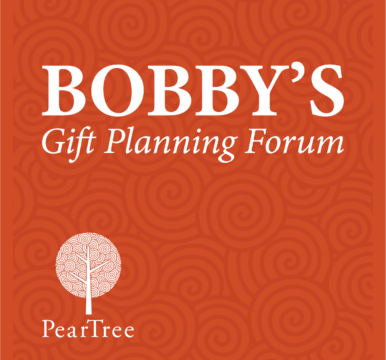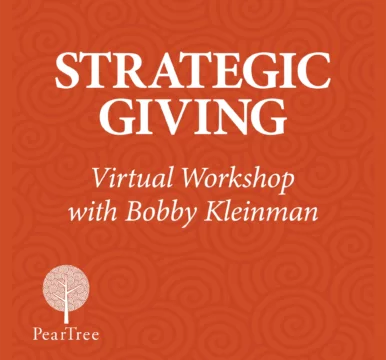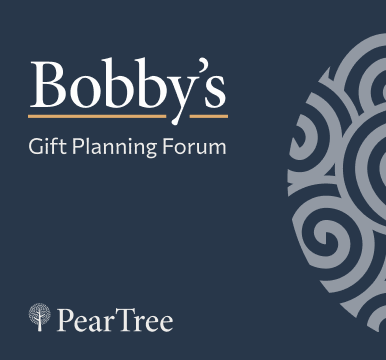This Forum contains the sole opinions & insights of the author based on forty years of providing advice to donors and charities. Others may totally disagree with the author’s views. This Forum is intended as a conversation. Robust debate is invited. Please respond with questions and alternative viewpoints to askbobby@peartreecanada.com
The last Forum examined the gift of insurance. This time we will look at insurance in the corporation.
Let’s start with some background:
- Big money in Canada is held in corporations; thus, very large donations are usually sourced from corporations.
- Insurance received on death is received tax-free, either personally or in the corporation. Corporations can usually pass out the tax-free proceeds to shareholders, also free of tax, via the capital dividend account (CDA). Effectively tax-free proceeds received by the company, 50% of capital gains, 100% of gains on a gift of marketable securities, and most of the proceeds from life insurance on death enter the CDA. Dividends elected out of CDA are received tax-free by Canadian shareholders.
- An individual, ‘Mr. A’ wishes to take out a $1m policy on his life. He has a holding company. Does the company take out the policy, or does Mr. A? Mr. A‘s first reaction is to think personally, as he intends for the insurance proceeds to be received by his children. He is comforted by his accountant who explains because of the CDA, corporate-owned insurance proceeds will still wind-up tax-free to his children. After death, the corporation will pay a CDA dividend to the estate of the insurance proceeds, and the estate will pass the monies to the children. He realizes that to get him the annual premiums of $50,000 the company will have to pay him an $80,000 dividend, so that after personal tax, he will have left $50,000 to pay the premiums. Alternatively, if the company owns the policy, it will pay $50,000 of premiums directly. Premiums are not tax deductible, but it is still better in the company. Therefore, what is his choice – the corporation.
- If Mr. A owns 100 common shares of the company and passes away (assuming no spouse), he is deemed to dispose of the shares at the date of death. Assuming nil cost base of the shares and $1m of assets in the company, he may have a $500,000 taxable capital gain on his final tax return and perhaps $250,000 of tax to pay. The value of the shares of $1m is actually determined just prior to death. This seems peculiar, the moment just before, but it is helpful.
- A’s company did take out the $1m policy, and the company has paid the premiums for many years. Mr. A passes away. In valuing the company how does the life insurance policy affect the value? Certainly, the $1M policy is of value to the company. However, for purposes of the tax valuation, which is established immediately before death, the value of the policy need not be counted in the value of the shares, save for the cash surrender value, if any, since the proceeds are only payable after death.
- Thus, paying premiums of a policy is actually an estate planning mechanism to save estate taxes. If Mr. A pays out the entire $1m in his company as premiums leaving the company with no assets, except for the life insurance policy, he has converted a taxable asset into a non-taxable one. A popular plan was for the company to buy an annuity with the $1m and with the annual annuity proceeds pay out premiums on a $1m policy and retain some annuity proceeds as a net annual return.
We will now examine a corporate legacy gift estate plan, which I have shown to numerous entrepreneurs as part of their education on gift planning. It is simple in structure and not hard to understand.
Mr. and Mrs. A own the shares of a company. The company is worth $5m without a cost base. When the second passes away, there will be a $2.5m taxable capital gain and $1.25m of tax to pay on the shares. They have two children. They would love to make a major legacy gift to a charity as long as the gift does not materially affect the bequests to children.
The ‘As’ sit with their accountant to see if a plan exists to reduce the tax liability at death. Maybe, they will buy a tax shelter in the year of the second death. The accountant responds that it is hard to plan such a purchase as who really knows when one dies and the deathbed is not the typical place to shop tax shelters.
However, he adds that there is a potential convergence of attributes at death. One, insurance proceeds are paid and two, the will is read. Since a will gift can result in a reduction of estate taxes perhaps there is a viable plan.
The corporation takes out a $1m last-to-die, term-to-100 policy on the lives of the ‘As’. It pays $40,000 a year in premiums, not deductible. Their joint mortality, is 16 years, and let us assume that the last-to-die is in 16 years. Each of their wills leaves each other their assets, but if one predeceases, then there is a $1m gift to Charity (of course, paid from appreciated marketable securities, if possible) and the balance of the estate, equally, to the two children.
Sixteen years later, the last death occurs. The value of the policy does not increase the value of the shares at death. $1m comes into the company (the insurance) and is passed out to the estate and $1m is paid to the Charity. A donation receipt is received which saves the estate $500,000. So the gift is made, terrific, and the tax savings are in hand – all looks good. However, there is a cost – all those premiums which have been paid. The company has paid out $640,000 of premiums. That is obviously a negative, but not completely. As the company’s value has been eroded by $640,000, then the capital gain at death on the shares is reduced by $640,000 and $160,000 of tax is saved.
Therefore, we are up $500,000 of tax, $160,000 of tax and down $640,000 of premiums for a net gain of $20,000. In essence, the family is wealthier by $20,000 to give $1m. This certainly meets the A’s requirement not to impinge too much on the children’s bequests.
This analysis is too simple. It is more accurate to look at the time value of money, the tax savings at death are in 16 years and we are starting to pay the premiums now.
So present value the tax savings from the gift, $500,000 at 16 years and 2.5% interest. Present value the $40,000 cost per year for 16 years and come up with a total present value cost, and then discount that number by 25% for the capital gains tax savings. Now when computing the final cost or gain we will see that the net gain of $20,000 will actually be a net cost in today’s dollars of say $40,000.
Still pretty good. To make a $1m gift the cost in today’s dollars is $40,000. The ‘As’ are pleased. However, wait, there is a benefit. The estate is not going to pay cash to the Charity. It will pay with appreciated securities and avoiding capital gains tax on those securities. This additional savings usually brings the cost of giving to nil.
When I present this plan to entrepreneurs, it is with someone else’s numbers or mortality, just as an example. I explain that it doesn’t always work so well, then I ask if I could get their birthdays and get a quote on last-to-die term-to-100 insurance to see if it works for them.
That gets me a second meeting. The objective of the first meeting is to leave the prospective legacy donor that it doesn’t have to cost that much to leave a major gift – the children will be just fine.
The mood has been set for a wonderful gift!
We’d love to hear from you! Please direct any questions to askbobby@peartreecanada.com and the answers will appear in the next Forum.
Robert (Bobby) K leinman FCPA, FCA
leinman FCPA, FCA
Bobby started in philanthropy in August of 1994 by becoming the Executive Director of the Jewish Community Foundation of Montreal (JCF) which is seen to be Canada’s most donor-centred foundation.
Previously a Partner in Taxation at Ernst and Young, he is now a Planned Giving Consultant specializing in tax-assisted giving. Bobby has helped many Canadian charities design their planned giving programmes, and has written numerous articles on the subject. He is also Past-President of the Conseil de la Philanthropie du Quebec, the Table Ronde du Quebec of the CAGP, JIAS Canada, JIAS Montreal, and the Mount Royal Tennis Club.



